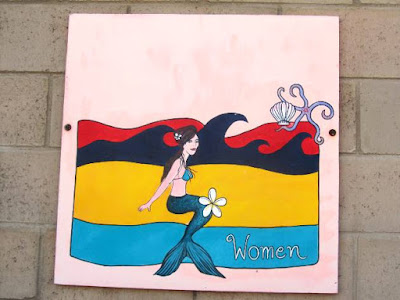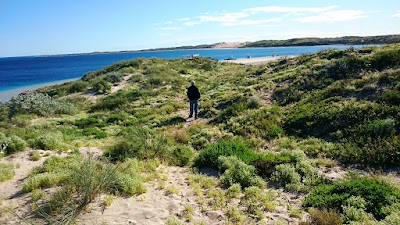Today we left the tropics for the first time since we left Alice Springs on May 19. This could be the beginning of the cold weather.
Quobba Point is approx 70 km north of Carnarvon, and we
stayed at Quobba Station north of the point. Carnarvon is one of WA's major
fruit growing areas. Bananas and tomatoes seem to be popular crops, but at the
moment yields are down because of cyclone damage earlier in the year. There are
many shadecloth screens which have been damaged and are in the process of being
replaced.
We decided not to stay in Carnarvon, to leave it until
another trip, and head instead to Quobba Point.
We were impressed that there might actually be power out
there as we followed the power lines for many kms, past the salt pans of Lake
MacLeod, until the line suddenly disappeared near the entrance to Rio Tinto’s
Dampier Salt mine. I can’t say we were surprised. At Quobba there were 2
options. The Point, which was not supposed to have any toilets, or the Station,
8 km up the road, which definitely did, and even had powered sites had we
wanted one.
Quobba Station is a working sheep property which breeds
Damara sheep for live export to Saudi Arabia. The sheep have a skin like a
goat, are bred for their lean meat and store their fat in their long fat tail.
They are native to Namibia.
The station is right on the coast and we spent quite a bit
of time watching the setting sun and searching for whales on their migration
north. There were lots, but getting a good photo of one has so far eluded me.
The beach is covered with a layer of bleached clam shells which are very large
for shells on a beach.
 |
| A glassy beach |
 |
| There is a whale in this picture. Honest! |
 |
| Clam shells next to my foot |
Next morning we headed back to Quobba Point to the
blowholes, and to check out the area more fully. On the way we discovered the memorial cairn to HMAS Sydney, sunk off the coast near there on November 19, 1941, with no survivors.
The blowholes are mesmerising,
and have several spouts. Once again, with photos, timing is everything. I have
lots of photos of sky, empty sea, and a non-spouting blowhole.
 |
| The cliffs near the blowholes can be treacherous |
We drove for
quite a distance behind the beach, past shacks and shanties and dilapidated
vans. The water of the beach was crystal clear and beautiful and not that cold.
David looked longingly at the rock pool known as the Aquarium, but we had no
swimming gear with us. It did look inviting though.
 |
| The Aquarium |
 |
| Rocky outcrop off shore and crystal clear water |
 |
| The dunes behind the beach |
Next was a quick trip up to the lighthouse, where I suddenly
had a phone signal, and also a view of the piles of salt, home to check out the
results of a serious fishing expedition , then back up to the beach to check
out more whales and watch the sheep escaping from their pen in search of food.
It was a lovely relaxing interlude in a beautiful part of the coast.
 |
| Another toilet sign. If only..... |
 |
| A salutary message for this area. |













































